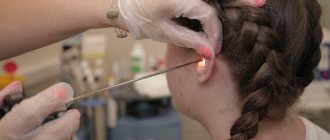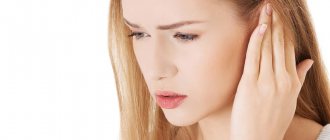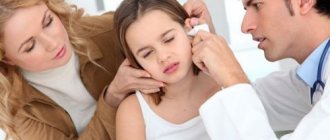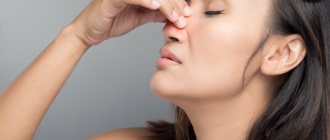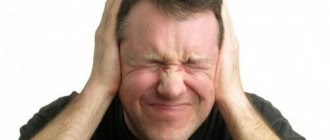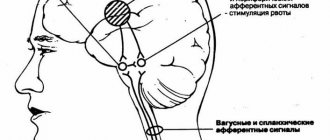Author:
- Khirnetkina Ayuna Fedorovna
otorhinolaryngologist, otoneurologist, audiologist
5.00 (Votes: 1)
The formation of earwax is a physiological process of the protective function of the external auditory canal; earwax is necessary for the normal functioning of the human ear. The main component of earwax is a secretion produced by glands that are located in humans in the deep layers of the skin of the external auditory canal, in its cartilaginous section and open into the hair follicles or into the skin. These are special sweat glands. Earwax also consists of the secretion of the sebaceous glands, which also open into hair follicles, desquamated skin particles, fatty acids, fat-like substances (lanosterol, squalene, cholesterol), mineral salts. Earwax is variable: it has a different smell, consistency and density - from soft, waxy to dry, stony, from light yellow-brown to dark brown, almost black. Representatives of the Mongoloid race have dryer earwax than Europeans, while African Americans have softer earwax. The variability of these qualities of earwax is associated with the genetic characteristics of a person.
Why do you need earwax at all?
Earwax is a substance produced by the natural secretion of glands in your ear canal. It kills bacteria, fungus and small insects like midges before they can reach the eardrum and cause an infection. When you chew, speak, or move your jaw, earwax is slowly removed from the ear, preventing wax plugs from forming. Although your body usually gets rid of old earwax on its own, it can still build up in your ear canal.
Reasons for changes in color and consistency
Change in earwax color during illness
Normally, earwax is a brown substance with a viscous consistency. Depending on the state of organs and systems, the color and density of sulfuric matter may change, which serves as the first sign of an incipient disease:
- The dark color of sulfur is a symptom of a hereditary pathology in which the tissue of blood vessels is damaged. It is called Randu-Osler-Weber syndrome. Another common symptom of this pathology is nosebleeds.
- Yellowish or green wax indicates a purulent process in one of the ear structures. The following symptoms accompany the pathology: acute pain in the ear, fever, intoxication, lymphadenitis. Before prescribing treatment, the doctor identifies the nature of the pathogenic microflora.
- Black sulfur (or sulfur that has a red tint) indicates that blood clots are present in the sulfur substance. This may indicate an injury to the eardrum or a tumor process in the auditory canal. This sulfur is a symptom of a fungal infection (otomycosis).
- Gray color indicates the presence of a large amount of dust in the sulfuric matter.
- White sulfur is a symptom of hypovitaminosis and a lack of certain microelements. In this case, copper or iron deficiency is most likely.
- Dry sulfur is a symptom of dermatitis and other skin diseases.
- Liquid, flowing sulfur appears when the eardrum is perforated or there is an inflammatory process in the ear.
Do you need to clean your ears yourself?
There are a number of studies and sources that advise against using ear cleaning utensils, such as cotton swabs or tweezers. Brushing too vigorously or applying too much pressure can cause severe and permanent hearing loss. There are also non-invasive methods, such as earwax removal kits or special drops, but their effectiveness and safety remain in question.
It is not recommended to clean the ear canal yourself. Your body has a built-in function to remove earwax, so additional intervention is only necessary for earwax impactions. To remove them, you must consult a doctor who will perform the procedure safely, quickly and painlessly.
Preventing the formation of wax plugs
It is important to monitor the health of your ears. A few preventative measures will help preserve it for many years. They are:
Read also: Causes, symptoms and treatment of sinusitis in adults
- Avoid getting water into your ears.
- Do not use cotton swabs to remove wax from the inner parts of the ear canal.
- Promptly carry out prevention and treatment of infectious ENT diseases, protect your ears from colds and inflammations.
- Monitor your small child so that, while playing, he does not insert a foreign object into the ear canal and damage the skin and fragile eardrum.
- Use special gauze pads or swabs to clean the outer ear.
- Visit an otolaryngologist once a year for preventive examinations.
The process of wax formation in the external auditory canal is provided by nature itself to maintain healthy ears and good quality of hearing. This is not dirt, but a protective lubricant designed to clean, disinfect and moisturize external structures that communicate with the external environment. And the formation of traffic jams can be easily avoided if you follow simple recommendations.
Does earwax damage hearing aids?
If you wear hearing aids, you will need to take more care of your ears. Hearing aids can stimulate earwax production while blocking your ears' natural removal of wax. This can lead to a number of problems, including wax build-up and damage to your hearing aids. You will also have to change your earmold more often.
If earwax is not removed naturally or mechanically, it will accumulate in your ear. This can lead to subsequent hearing problems, ear discomfort, and even infections. In order for a hearing aid to do its job one hundred percent, it is necessary that the ear canal is clean and that earwax does not impede the conduction of sound. Otherwise, sound waves will be reflected from the wax plug, which can cause unpleasant feedback.
Ear hygiene prevents hearing aid failure. Wax can get into microphones and vents, preventing your hearing aids from working properly. Earwax chemicals can destroy important components of the hearing aid.
Approximately 60-70% of all damaged hearing aids sent for repair are simply clogged with earwax or organic materials. Because your hearing aids come into constant contact with your skin and ears, it is important to keep these areas clean. Keeping your hearing aids clean will help increase their lifespan.
Symptoms of wax plugs in the ears
In some cases, the appearance of wax in the ear causes pain due to the constant increase in its size and weight. However, most patients do not complain of pain until the ear canal is completely blocked. The pathology manifests itself unexpectedly - water enters the ear, causing a very rapid increase in the volume of the plug.
When the ear canal is blocked, the following symptoms are observed.
- the patient hears ringing in the ears;
- hearing decreases;
- dizziness and headaches appear;
- the patient feels that the ear canal is blocked;
- the patient suffers from localized pain.
A fairly common symptom is that when talking, the patient feels the reflection of his voice in the affected ear. In addition, in some cases the eardrum is under severe pressure, which provokes nausea, cough, and migraine. Prolonged pressure on the membrane can cause myringitis and otitis media.
When the first symptoms of a wax plug in the ear appear, you should immediately contact a qualified specialist who will conduct a comprehensive examination and prescribe appropriate treatment.
When is it necessary to contact a specialist?
It's hard to know when exactly your ears will need cleaning. If you notice a periodic build-up of earwax, try synchronizing your cleansing schedule to resolve the problem. If you suffer from ear pain, whistling when using hearing aids, or excessively dirty hearing aids, contact your doctor or your hearing care professional immediately. Under no circumstances should patients with perforated eardrums or ear infections perform self-cleaning.
Based on materials from signia-hearing.ru
Introduction
The ear is an important organ for cognition of the surrounding world.
But at the same time, it is also a “gateway” for the entry of various infections. To prevent negative influences from the outside, there is a special secret in the ears - earwax . It is a viscous substance, usually dark yellow to brown, produced in the ear canal of all mammals, including humans.
Story
An ear cleaner that cares for a man's ear.
Gouache painting, Delhi, 1825. Treatment of excess earwax was described by Aulus Cornelius Celsus in De Medicina
in the 1st century:[45]
When a person’s hearing becomes dull, which most often occurs after prolonged headaches, the ear itself should be examined first: as a crust will be detected that appears on the surface of the body. ulcerations, or waxy nodules. If the crust is poured with hot oil, either Verdigris mixed with honey or leek juice or a little soda in honey wine. And when the crust is separated from the ulcer, the ear is irrigated with cool water to facilitate the removal of the crusts, which are now separated from the ulcer. ear scoop. If it is wax, and if it is soft, it can be extracted in the same way using an ear spoon; but if it is difficult, vinegar containing a little carbonation[46] is introduced; and when the wax has softened, the ear is washed and cleaned as above. ... Next, you need to syringe castoreum mixed with vinegar and laurel oil and juice of young radish peels, or cucumber juice mixed with crushed rose leaves into the ear. Dripping the juice of unripe grapes mixed with rose oil is also quite effective against deafness.
Uses
- In the Middle Ages, earwax and other substances such as urine were used to prepare pigments used by scribes to illustrate illuminated manuscripts.[47]
- Pliny the Elder, in his Natural History, wrote that earwax - when applied topically - cures the bites of people, scorpions and snakes; It is said to work best when removed from the ears of a wounded person.[48]
- The first lip balm may have been based on earwax.[49] An 1832 edition of the American Thrifty Housewife
said that "there is nothing better than earwax to prevent the painful effects resulting from a wound with a nail [or] skewer"; and earwax is also recommended as a remedy for cracked lips.[50] - Before waxed thread became widely available, seamstresses used their earwax to prevent the cut ends of threads from fraying.[51]
Notes
- "Earwax". american-hearing.org
. Chicago, IL: American Foundation for Hearing Research. 2008. Archived from the original on February 25, 2009. Retrieved February 12, 2009. - ^ a b c
Khan S (2019).
"Sulfur plug." APRNs and PAs' Complete Guide to Prescribing Drug Therapy
. Doi:10.1891/9780826179340.0061. ISBN 978-0-8261-7933-3. S2CID 1415169. - ^ a b
Okuda I, Bingham B, Stoney P, Hawke M (June 1991).
"Organic composition of earwax." Journal of Otolaryngology
.
20
(3): 212–5. PMID 1870171. - Alvord L.S., farmer B.L. (December 1997). "Anatomy and orientation of the human external ear". Journal of the American Academy of Audiology
.
8
(6): 383–90. PMID 9433684. - ^ a b c d f g hr
Guest J.F., Greener M.J., Robinson A.S., Smith
A.F. (August 2004). "Affected sulfur: composition, production, epidemiology and management." Q.J.M.
_
97
(8):477–88. Doi:10.1093/qjmed/hch082. PMID 15256605. - ^ a b
Overfield T (1985).
Biological differences in health and disease: Race, age, and sex differences
. Menlo Park, CA: Addison-Wesley, Department of Nursing. n.. ISBN 978-0-201-12810-9. ... the most common type in whites and blacks is dark brown and wet. Dry wax, most common among Orientals and Native Americans, is gray and dry. It flakes off and may form a thin mass that lies in the ear canal. - "The Science of Stinky Sweat and Earwax." April 14, 2015
- Bass EJ, Jackson JF (September 1977). "Ceremous types among the Eskimos." American Journal of Physical Anthropology
.
47
(2): 209–10. Doi:10.1002/ajpa.1330470203. PMID 910884. - “Various thoughts about the Ainu, I.” Ahnenkult.com. Retrieved April 28, 2014.
- Diep F (February 13, 2014). “The smell of your earwax can provide valuable information | Popular Science". Popsci.com. Retrieved April 28, 2014.
- Online Mendelian Inheritance in Man (OMIM): 117800
- Yoshiura K., Kinoshita A., Ishida T., Ninokata A., Ishikawa T., Kaname T., et al. (March 2006). "A SNP in the ABCC11 gene is a determinant of human earwax type." Nature Genetics
.
38
(3): 324–30. doi:10.1038/ng1733. PMID 16444273. S2CID 3201966. - Alberti P.V. (September 1964). "Epithelial migration on the tympanic membrane". Journal of Laryngology and Otology
.
78
(9):808–30. Doi:10.1017/s0022215100062800. PMID 14205963. - Harvey DJ (September 1989). "Identification of long-chain fatty acids and alcohols from human serum sulfur using picolinnyl and nicotinate esters." Biomedical and Environmental Mass Spectrometry
.
18
(9): 719–23. Doi:10.1002/bms.1200180912. PMID 2790258. - Bortz JT, Wertz PW, Downing DT (November 1990). "Composition of sulfur lipids". Journal of the American Academy of Dermatology
.
23
(5, Pet. 1): 845–9. Doi:10.1016 / 0190-9622 (90) 70301-B. PMID 2254469. - Nichols AC, Perry ET (September 1956). "Studies of bacterial growth in the human ear canal." Journal of Investigative Dermatology
.
27
(3): 165–70. Doi:10.1038/jid.1956.22. PMID 13367525. - TJ Tea, TC Tea (October 1980). "Bactericidal effect of sulfur." Antimicrobials and chemotherapy
.
18
(4): 638–41. Doi:10.1128/aac.18.4.638. PMC 284062. PMID 7447422. - Stone M., Fulhum R.S. (1984). "Bactericidal effect of wet sulfur." Annals of Otology, Rhinology and Laryngology
.
93
(2 Pt 1): 183–6. Doi:10.1177/000348948409300217. PMID 6370076. S2CID 30717377. - Megarry S., Pett A., Scarlett A., Te W., Zeigler E., Kanter R. J. (August 1988). "Activity against human sulfur yeasts". Journal of Laryngology and Otology
.
102
(8):671–2. Doi:10.1017/s0022215100106115. PMID 3047287. - Roland P.S., Marple B.F. (December 1997). "Diseases of the external auditory canal." Journal of the American Academy of Audiology
.
8
(6): 367–78. PMID 9433682. - Campos A., Arias A., Betancore L., Rodriguez S., Hernandez A. M., Lopez Aguado D., Sierra A. (July 1998). "Study of the general aerobic flora of human sulfur". Journal of Laryngology and Otology
.
112
(7):613–6. doi:10.1017/s002221510014126x. PMID 9775288. - ^ a b
"From A to Z: Damaged Cerumen (for parents) - Nemours."
kidshealth.org
. Retrieved August 17, 2021. - Yusuf Hussein S, Swanepoel W, Magomed-Asmail F, de Jager LB (December 2021). “Hearing loss in preschool children from a low-income South African community.” International Journal of Pediatric Otorhinolaryngology
.
115
: 145–148. Doi:10.1016/j.ijporl.2018.09.032. PMID 30368375. - Chou, R.; Dana, T.; Bougatsos, C.; Fleming, C.; Bale, T. (March 2011). “Screening for Hearing Loss in Adults Ages 50 and Older: Review of Evidence for the US Preventive Services Task Force.” Summary of Evidence, No. 83
. US Agency for Healthcare Research and Quality (AHRQ). PMID 21542547. Received July 5, 2013. - Oliveira R.J. (December 1997). "Active ear canal." Journal of the American Academy of Audiology
.
8
(6): 401–10. PMID 9433686. - Aleccia J (August 29, 2021). "The Dangers of Excessive Earwax."
- ^ a b
Schwartz SR, Magit AE, Rosenfeld RM, Ballachanda BB, Hackell JM, Krouse HJ, et al. (January 2021).
"Clinical Practice Guidelines (Update): Earwax (Ear Wax) Summary." Otolaryngology - head and neck surgery
.
156
(1):14–29. Doi:10.1177/0194599816678832. PMID 28045632. - ^ a b c d e
Clegg AJ, Loveman E, Gospodarevskaya E, Harris P, Bird A, Bryant J, et al.
(June 2010). "Safety and effectiveness of different earwax removal methods: a systematic review and economic evaluation." Health Technology Assessment
.
14
(28): 1–192. Doi:10.3310/hta14280. PMID 20546687. - ^ a b c d e g
Sharp, J. F., Wilson, J., Ross, L., Barr-Hamilton, R. M. (December 1990).
"Ear Wax Removal: A Review of Current Practice." BMJ
.
301
(6763):1251–3. doi:10.1136/bmj.301.6763.1251. PMC 1664378. PMID 2271824. - ^ a b
"Ear wax". Tchain.com. Retrieved May 2, 2010. - Aaron K, Cooper TE, Warner L, Burton MJ. (July 2021). "Ear drops to remove earwax." Cochrane Database of Systematic Reviews
.
7
: CD012171. Doi:10.1002/14651858.CD012171.pub2. PMC 6492540. PMID 30043448. - Fraser JG (October 1970). "Efficacy of wax solvents: in vitro studies and clinical trials." Journal of Laryngology and Otology
.
84
(10): 1055–64. Doi:10.1017/s0022215100072856. PMID 5476901. - ^ a b
Wilson PL, Roeser RJ (December 1997).
"Sulfur processing: professional issues and methods." Journal of the American Academy of Audiology
.
8
(6): 421–30. PMID 9433688. - Coppin, R., Wicke, D., & Little, P. (2011). "Randomized trial of earwax ball syringes: impact on health care utilization." Annals of Family Medicine
.
9
(2): 110–4. Doi:10.1370/AFM.1229. PMC 3056857. PMID 21403136. - ^ a b c d e
Blake P, Matthews R, Hornibrook J (November 1998).
“When not to syringe your ear.” New Zealand Medical Journal
.
111
(1077):422–4. PMID 9861921. - ^ a b
Ernst A.A., Takakuwa K.M., Letner S., Weiss S.J.
(September 1999). "Warm saline versus room temperature saline for ear irrigation: a randomized clinical trial." Annals of Emergency Medicine
.
34
(3): 347–50. Doi:10.1016/S0196-0644 (99) 70129-0. PMID 10459091. - ^ a b
Bull, P. D. (2002).
Lecture notes on diseases of the ear, nose and throat
(6th ed.). Oxford: Blackwell Science. pp. 26–27. ISBN 978-0-632-06506-6. - Evidence Based Wax Removal Protocol Archived March 4, 2016 Wayback Machine
- ^ a b
Seeley D.R., Quigley S.M., Langman A.V.
(October 1996). "Ear candles - effectiveness and safety." Laryngoscope
.
106
(10):1226–9. Doi:10.1097/00005537-199610000-00010. PMID 8849790. S2CID 45885657. - “Ear candles: burns | PeopleHearingBetter.” phb.secondsensehearing.com
. Retrieved April 16, 2021. - ^ a b
“Earwax.”
www.entnet.org
. American Academy of Otolaryngology. Retrieved April 23, 2012. - Leong AS, Aldren S (August 2005). "A non-randomized comparison of earwax removal using a DIY ear vacuum kit and a Jobson-Horn probe." Clinical Otolaryngology
.
30
(4): 320–3. Doi:10.1111/j.1365-2273.2005.01020.x. PMID 16209672. S2CID 21943297. - Grossan M (July 1998). "Sulfur removal - current problems." Ear, Nose and Throat Magazine
.
77
(7):541–6, 548. doi:10.1177/014556139807700710. PMID 9693470. S2CID 43201167. - Joubert, K., Botha, D. (February 2021). "Factors Contributing to the High Prevalence of Hearing Impairment in the Elias Motsoaledi Municipal Area, South Africa: A Rural Perspective." South African Journal of Communication Disorders = die Suid-Afrikaanse Tydskrif vir Kommunikasieafwykings
.
66
(1): e1–e7. Doi:10.4102/sajcd.v66i1.611. PMC 6407449. PMID 30843412. - Celsus AC, Translation by W.G. Spencer. "Book VI". De Medicina
. - "Acetum et cum eo nitri paulum"
.
Nitri
is shown here as “carbonation”, i.e. soda ash, although the word can refer to a variety of alkaline substances or sodium nitrate. (https://www.archives.nd.edu/cgi-bin/words.exe?nitri https://www.history-science-technology.com/Notes/Notes%208.htm) Note that carbonate acidification sodium gives sodium bicarbonate. - "Iberian manuscripts (pigments)". Web.ceu.hu. Retrieved April 28, 2014.
- "Pliny the Elder, Natural History," BOOK XXVIII. REMEDIES OBTAINED FROM LIVING CREATURES., CHAPTER 8. - REMEDIES EXTRACTED FROM HUMAN EAR.” www.perseus.tufts.edu
. Retrieved April 8, 2021. - Schwaab M., Gurr A., Neumann A., Dusert S., Minowi A. (August 2011). "Human Antimicrobial Proteins in Earwax". European Journal of Clinical Microbiology and Infectious Diseases
.
30
(8):997–1004. doi:10.1007/s10096-011-1185-2. PMID 21298458. S2CID 20731975. - Child L. M. (1841). American Frugal Housewife... - Google Books
. item 116. Received May 2, 2010. - Beaudry MC (2009). "Biographies of Bodkin".. In white CL (ed.). The materiality of individuality
. New York, NY: Springer. pp. 95–108. - Nelson K.S. “What can you tell us about whale earwax?” cs.ucf.edu. Archived from the original on June 29, 2011. Retrieved June 20, 2010.
- Osborne, D. (September 17, 2013). "Earwax Reveals a Whale's Tale." Australian Broadcasting Corporation.
- Trumble, S. J., Robinson, E. M., Berman-Kowalewski, M., Potter, S. W., Usenko, S. (October 2013). "Blue Whale Earplugs Reveal Lifetime Pollutant Exposure and Hormone Profiles." Proceedings of the National Academy of Sciences of the United States of America
.
110
(42):16922–6. Bibcode:2013PNAS..11016922T. doi:10.1073/pnas.1311418110. PMC 3801066. PMID 24043814. - Trumble SJ, Norman SA, Crane DD, Mansouri F, Winfield ZS, Sabin R, et al (November 2021). "Balice whale cortisol levels reveal a physiological response to 20th century whaling." Nature Communications
.
9
(1): 4587. Bibcode:2018NatCo... 9.4587 t. Doi:10.1038/s41467-018-07044-w. PMC 6215000. PMID 30389921.

